






Netherlands American Cemetery and Memorial and the tradition of adopting graves
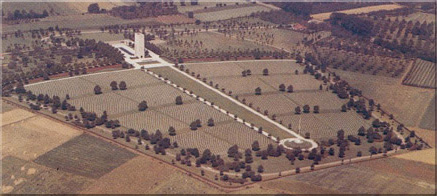 The
World War II Netherlands American Cemetery and Memorial is the only cemetery
of this kind in the Netherlands. It lies in the village of Margraten in the
southern part of the Province of Limburg. The cemetery's site has a rich historical
background, lying near the famous Cologne-Boulogne highway, originally built
by the Romans and used by Caesar during his campaign in that area.
The
World War II Netherlands American Cemetery and Memorial is the only cemetery
of this kind in the Netherlands. It lies in the village of Margraten in the
southern part of the Province of Limburg. The cemetery's site has a rich historical
background, lying near the famous Cologne-Boulogne highway, originally built
by the Romans and used by Caesar during his campaign in that area.
Three months after the successfully landings on the beaches of Normandy, Allied
forces had advanced farther than they had thought possible. By mid-September
1944, the U.S. First Army had crossed Luxembourg; captured Liege, Belgium; reached
the German frontier near Aachen; and entered the Netherlands near Maastricht.
The U.S. Third Army sweeping across France on the right had reached the Moselle
River and made contact with the U.S. Seventh Army driving northward from southern
France. The British Second Army on the left had liberated Brussels and Antwerp,
as the Canadian First Army kept pace with it along the coast liberating Ostend
and Bruges. Both Armies then found themselves astride the Netherlands frontier
The site of the cemetery was liberated on 13 September 1944 by troops of the
U.S. 30th Infantry Division (Old Hickory) which were advancing northeastward
toward the Roer in Germany, as part of the U.S. First Army. A battlefield cemetery,
one of the first to be us ed for the interment of American soldiers who fell
on German soil, was established here on 10 November 1944 by the U.S. Ninth Army.
Here rest 8,301 of the U.S. military Dead, representing 43 percent of those
who were originally buried in this and in other temporary cemeteries in this
region. Most of them gave their lives in the airborne and ground operations
to liberate eastern Holland, during the advances into Germany over the Roer
and across the Rhine and in air operations over these regions.
From the entrance gate on
the south side of the Maastricht-Aachen highway the approach drive leads to
the right, around a grassed oval, to the steps leading to the Court of Honor.
The Court of Honor of the memorial leads to the tower containing the chapel.
Beyond the chapel is the burial area. The cemetery and memorial in its present
state were completed in1960.
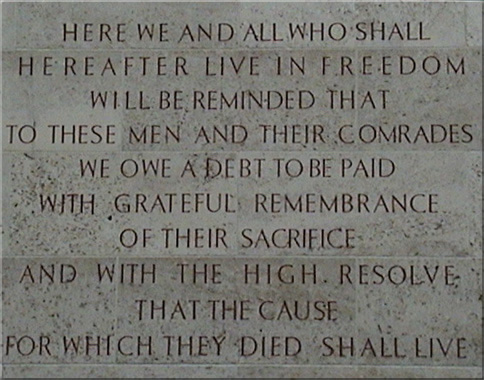 The
Memorial
The
Memorial
When approaching the entrance to the Court of Honor the Visitors’ Building
is situated on the right side. On the left side is the museum room.
On the exterior wall of the museum is this inscription taken from General Dwight D. Eisenhower’s dedication of the Golden Book in St. Paul’s Cathedral in London:
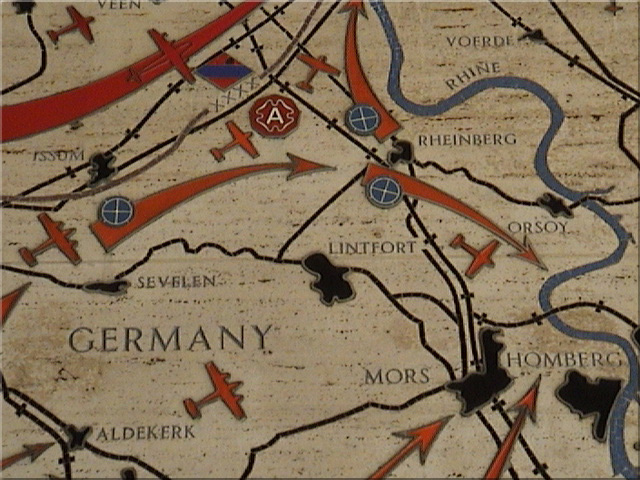
Engraved on the Roman Travertine walls within the museum are three maps which records the progress of the military operations from the landings in Normandy until the end of the war. Below the maps are insignia of the principal major units which participated in these operations.
Court of Honor
Extending from the steps to the tower is the Court of Honor with its reflecting
pool. Engraved on the north and south walls of the Court are the names, rank,
organization and the State of 1,722 of the Missing of the Army and Army Air
Forces. These men gave their lives in the service of their Country in this region,
but their remains have not been recovered or identified. Without confirmed information
to the contrary, a War Department administra-tive Review Board established the
official date of death of those commemorated on the Tablets to the Missing as
one year and a day from the date on which the individual was placed in Missing
in action status.
The bronze group standing before the tower at the East End of the Court of Honor
was designed by Joseph Kiselewski, of New York City and cast in Milan by the
Battaglia foundries.
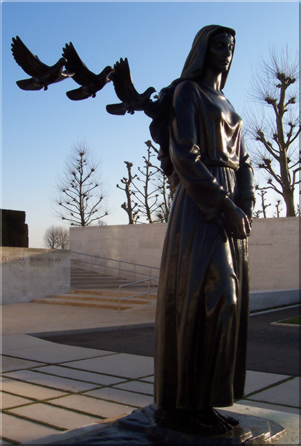 |
The mourning figure, representing the grieving mother of her lost son, the doves, the new shoot from the war destroyed tree are appositely described by the inscription on the stone base:
NEW LIFE FROM WAR’S DESTRUCTION PROCLAIMS MAN’S IMMORTALITY AND HOPE FOR PEACE
The west face of the tower bears this inscription from a free translation of Pericles’ oration as recorded by Thucydides:
EACH FOR HIS OWN MEMORIAL
EARNED PRAISE THAT WILL NEVER DIE
AND WITH IT
THE GRANDEST OF ALL SEPULCHRES
NOT THAT IN WHICH
HIS MORTAL BONES ARE LAID
BUT A HOME
IN THE MINDS OF MEN
On the walls flanking it
to the left and right are the names of significant battles fought by the soldiers
and airmen commemorated:
MAASTRICHT * EINDHOVEN * GRAVE * NIJMEGEN * ARNHEM * JULICH * LINNICH * GEILENKIRCHEN
* KREFELD * VENLO * RHEINBERG * COLOGNE * WESEL * RUHR
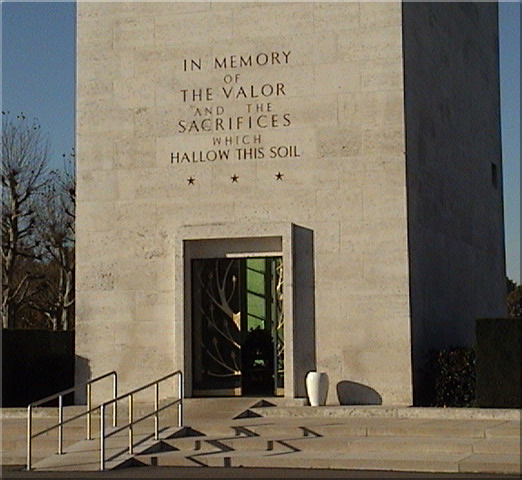
The entrance to the chapel, reached after mounting a few steps, is on the east, the burial area side, of the tower. The doors are of bronze fabricated by H. H. Martyn of Cheltenham, England and bear in outline a Tree of Life. Above them is engraved:
Graves area
The burial area is divided into 16 plots, lettered from A to P, separated by
the broad central mall and by grass paths. The 8,301 headstones are arranged
in parallel arcs sweeping across the broad green lawn. At the top of the hill,
on the axis of the mall, is the flagstaff.
 |
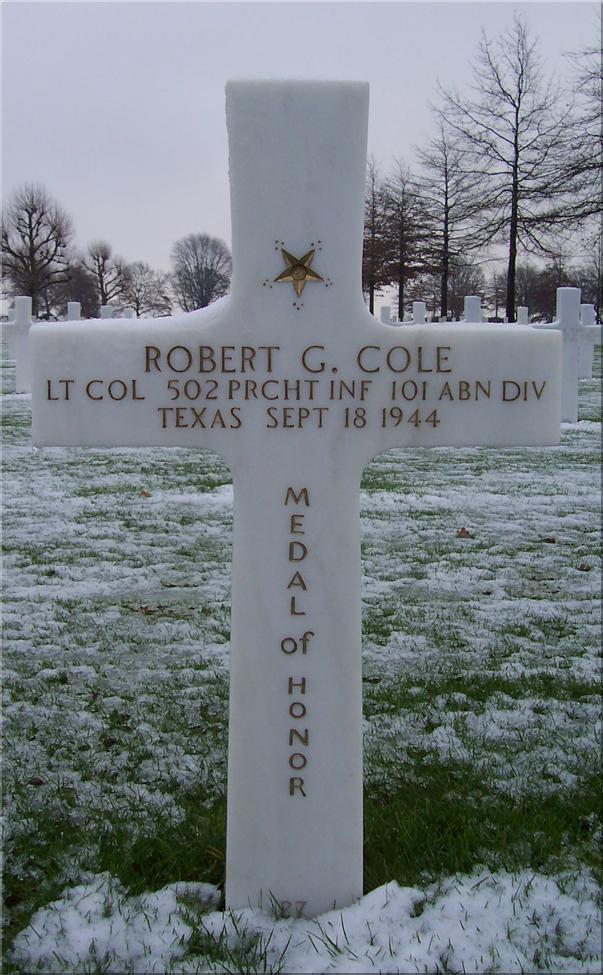 |
Picture
of Lt. Col. Robert G. Cole´s grave : some of the stories of
a soldier buried at the Margraten cemetery are told through contemporary
media : the story of Medal of Honor recipient Lt. Col. Robert G. Cole
from Texas and his unit of the 502nd PIR is told in a historically authentic
WWII videogame called "Brothers in Arms". |
Visitor’s
building
The Visitors’ Building is located on the south side of the Court of Honor.
Within it is a comfortably furnished lounge where visitors may obtain burial
locations or other information from the cemetery staff or simply pause to relax
and refresh themselves.
The cemetery is open daily
to the public from 9:00 am to 5:00 pm except December 25 and January 1. It is
open on host country holidays. When the cemetery is open to the public, a staff
member is on duty in the Visitors’ Building to answer questions and escort
relatives to grave and memorial sites.
Adopting graves at the Netherlands American Cemetery and Memorial Margraten
Originally the Cemetery was designated to the US Ninth Army. At first the 611th Graves Registration Company, led by Captain Joseph James Shomon planned a location near the city of Sittard. But at the time Sittard was situated at the front line. When Shomon started his preparations for the Cemetery his company was shot at by American and German units alike. So soon he was forced to look out for another location.
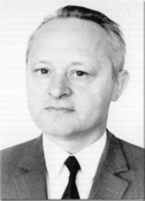 |
Joseph
van Laar |
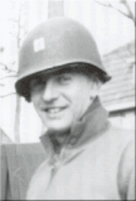 |
Captain
J.J. Shomon |
After some cross country reconnaissance their attention was drawn to a field near the village of Margraten. There Shomon contacted Joseph van Laar, who later played a very important role in what became known as the local adoption tradition. After Shomon had uttered his final and convincing statement : ‘ Listen Joe, the best soil is not good enough for our boys’, the decision making had been concluded and Margraten was definitely designated as the area for the Ninth Army Military Cemetery.
In November 1944 the actual work in the field started. On november 10 the first soldier was buried at Plot A, Row 1, Grave 1. At this time the fallen soldiers were buried in a linen bag accompanied by a brief ceremonial. Soon 19.000 soldiers were laid at rest at the Cemetery. The year 1944 had the coldest winter in years, comparable to a Siberian winter, so the circumstances under which the ‘diggers’ (the all-black 3136th Quartermaster Service company) had to do their work were the harshest imaginable. The ‘headstones’ were constructed of simple wooden crosses with the soldier’s tag attached to it. A year later these crosses beared the soldiers name and his Service number. At the end of the fourties the soldiers were reburied and their remains were placed in a coffin made of steel and bronze innerworks. The next of kin in the U.S. were offered the opportunity to bring the body of their beloved son, brother or father back to the States to be buried at home. Many American families made the soulsearching decision not to bring back their beloved to the United States, considering that it was their beloved last wish to be buried next to his comrades. More than 11.000 soldiers were brought back to their homeland and 8300 stayed at Margraten. At that time the present-day marble headstones were placed along with the Court of Honor and the Chapel
In the waning days of World
War II, a couple of months after the southern part of the Dutch Province of
Limburg had been liberated by American units, a small Margraten civil committee
picked up the idea of adopting graves at the Cemetery, after Joseph van Laar
had been asked by a Captain Lane to watch out for the grave of Captain Lane’s
nephew John Land. A growing number of American soldiers asked Joseph van Laar
to visit a friend’s grave every now and then. The committee soon had set
up the complete register for the adoption of all the graves at the Ninth Army
Military Cemetery.
When the new cemetery marked its first Memorial Day, Dutch citizens from 60
local villages collected 20 truckloads of flowers so that every American grave
would be decorated on Memorial Day.
By 1946 thousands of local, and later from all over the Netherlands, people
volunteered.
In 2003 the task of the committee was handed over to the Foundation Adoption
Graves American Cemetery Margraten. This foundation is still working on the
revision of the adoption register. Nowadays younger generations are taking over
the honour of taking care of one or more graves.
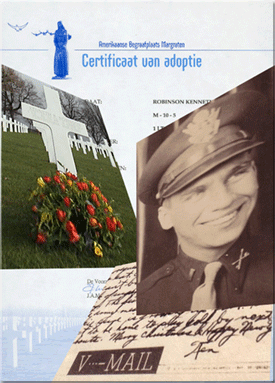 |
The adoption means:
- visiting the grave; the frequency is determined by the caretaker
- placing of flowers on special days or occasions (like e.g. Memorial Day or
Christmas)
- when relatives wish to do so, corresponding with the homeland
As an allowance for the foundation’s administration, people are asked to donate once-only a minimum contribution of 5 Euro.
Parents can pass on the adoption to their children, but are kindly entreated to forward any change (like changes of address or death notices) which could be of importance to the adoption register.
For more information you can visit the foundation’s web-site at www.adoptiegraven-margraten.nl , or click the “Foundation” button.
The Foundation Adoption Graves American Cemetery Margraten also offers the opportunity to order the book "Crosses in the Wind" (in English or Dutch), written by Captain Joseph James Shomon.
If you are interested in adopting a grave at the Netherlands American Cemetery and Memorial Margraten, please visit the site of the Foundation Adoption Graves American Cemetery Margraten.